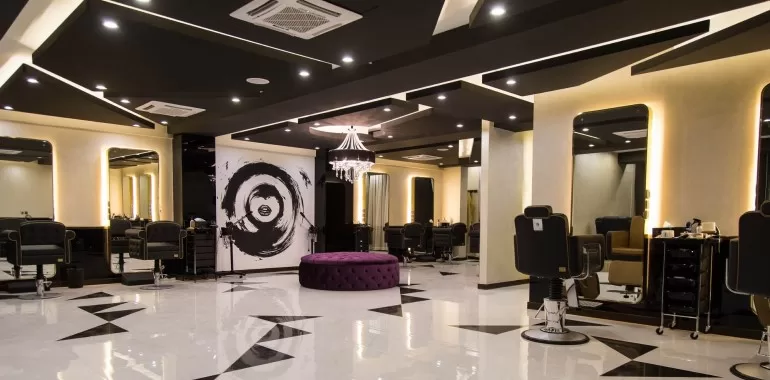False ceilings, also known as drop ceilings or suspended ceilings, have become an integral part of modern interior design. Originally used for hiding unsightly wiring, duct work, and plumbing, false ceilings now offer much more. They not only enhance the aesthetic appeal of a room but also improve its acoustics, lighting, and energy efficiency. Whether you’re designing a home, office, or commercial space, choosing the right false ceiling design can make a significant difference.
Here are various false ceiling design options that can elevate the ambiance and functionality of your interiors.
- Tray Ceilings: Layered Elegance
Tray ceilings, also known as recessed ceilings, are a popular choice for living rooms, dining areas, and master bedrooms. The ceiling is designed with a recessed central portion that can be square, rectangular, or even circular. The layered effect creates a sense of depth and adds a touch of sophistication to the room.
Design Features:
⦁ Lighting Options: Tray ceilings work exceptionally well with hidden cove lighting or LED strips that outline the recessed area, creating a warm, ambient glow.
⦁ Customization: You can further customize tray ceilings with moldings, different color paints for the recessed area, or even wallpaper, adding texture and style to the ceiling.
- Coffered Ceilings: Classic and Timeless
Coffered ceilings, characterized by a grid of sunken panels, are often associated with luxury and grandeur. This design has a rich historical background and is commonly found in traditional and classical interiors. However, modern adaptations have made coffered ceilings popular in contemporary homes as well.
Design Features:
⦁ Material Choices: Coffered ceilings are usually made of wood, MDF, or plaster, and they can be painted or stained to match the room’s decor.
⦁ Acoustic Benefits: The design helps reduce sound reverberation, making it ideal for large living areas or home theaters.
⦁ Customization: You can play with the shape and size of the coffers, incorporating square, rectangular, or even circular patterns for a unique aesthetic.
- Gypsum Board Ceilings: Versatile and Modern
Gypsum board, or drywall, is one of the most versatile materials used in false ceiling designs. It allows for easy installation, is lightweight, and can be molded into various shapes and styles. Gypsum ceilings are ideal for both residential and commercial spaces due to their sleek and modern look.
Design Features:
⦁ Curved Designs: Gypsum board allows for the creation of flowing, organic shapes, such as waves or circular designs, giving a contemporary touch to the ceiling.
⦁ Integrated Lighting: Recessed lighting or spotlights can be seamlessly integrated into gypsum ceilings, enhancing both functionality and aesthetics.
⦁ Soundproofing: Gypsum ceilings also offer good sound insulation, making them ideal for spaces where acoustic control is essential.
- POP (Plaster of Paris) Ceilings: Creativity Unlimited
Plaster of Paris (POP) is a highly malleable material used to create intricate false ceiling designs. It’s perfect for those looking for artistic and decorative ceiling patterns. POP ceilings offer flexibility in design and can be customized to suit any interior style, from contemporary to traditional.
Design Features:
⦁ Detailed Patterns: POP can be used to craft detailed floral designs, geometric shapes, or other intricate patterns that add a decorative element to the ceiling.
⦁ Combined with Lighting: POP ceilings can be paired with both recessed and accent lighting, creating dramatic visual effects.
⦁ Durability: POP is durable, moisture-resistant, and easy to maintain, making it an excellent choice for long-term use.
- Wooden Ceilings: Warm and Rustic
Wooden false ceilings add a touch of warmth, elegance, and natural beauty to any space. They are commonly used in living rooms, bedrooms, or areas where a cozy ambiance is desired. Wood can be used in various styles, from traditional beams to contemporary paneling.
Design Features:
⦁ Natural Appeal: Wooden ceilings bring a rustic or earthy charm to the room, especially when paired with other natural elements like stone or exposed brick.
⦁ Variety of Finishes: Wooden ceilings can be stained, painted, or left natural, depending on the look you want to achieve.
⦁ Insulation Benefits: Wood has natural insulating properties, helping to regulate room temperature and improving energy efficiency.
- Metal Ceilings: Sleek and Industrial
For a sleek, modern, and industrial look, metal false ceilings are a fantastic choice. Typically made of aluminum or steel, metal ceilings are durable, easy to maintain, and resistant to moisture and pests. They are often used in commercial spaces but can also be incorporated into residential designs for a contemporary touch.
Design Features:
⦁ Reflective Surfaces: Metal ceilings can reflect light, making the room feel brighter and more spacious.
⦁ Pattern Options: Metal tiles can come in a variety of patterns, including perforated designs that enhance the room’s acoustics.
⦁ Durability: Metal ceilings are fire-resistant, moisture-resistant, and long-lasting, making them ideal for kitchens or bathrooms.
- Glass Ceilings: Elegant and Transparent
Glass ceilings, though not as common, can create a unique and luxurious effect in a space. Often used in modern or minimalist homes, glass ceilings can add a sense of openness and brightness by allowing natural light to filter through.
Design Features:
⦁ Natural Light: Glass ceilings work best in areas where natural light can be maximized, such as in atriums, bathrooms, or sunrooms.
⦁ Frosted or Stained Glass: For added privacy and design flair, frosted or stained glass options can be used to create artistic effects.
⦁ Elegant Finish: Glass ceilings lend an elegant and sophisticated look, enhancing the overall ambiance of the room.
False ceiling designs have evolved to become an integral part of interior design, offering a variety of aesthetic and functional benefits. Whether you prefer the modern sleekness of gypsum board ceilings, the timeless charm of coffered designs, or the rustic warmth of wooden ceilings, there’s a false ceiling style to suit every taste. By carefully selecting the right design, materials, and lighting elements, you can transform any space into a stylish and functional environment.


